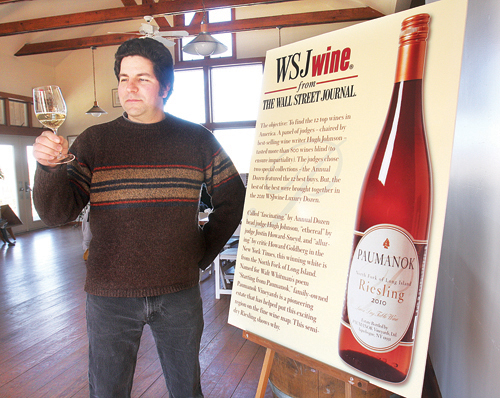Wall Street Journal ranks Paumanok riesling among the nation’s top 12

Kareem Massoud has been the winemaker at the family-owned Paumanok Vineyards since 2001.
Paumanok has been an estate winery since 1990, when Ursula and Charles Massoud renovated and re-built a turn-of-the-century potato barn.
“I’m a second generation, homegrown winemaker. I learned the trade under my father’s tutelage,” Mr. Massoud said.
His father, Charles Massoud, is still a big part of making the wine at Paumanok, though the day-to-day responsibilities are Kareem Massoud’s, he said.
And now the eldest son at Paumanok has a big feather to stick in his winemaking cap.
Recently, Paumanok’s 2010 Semi-Dry Riesling was chosen as one of the Wall Street Journal’s “luxury dozen,” the top 12 bottles of wine in the nation chosen in an 800-bottle blind judging, chaired by British author and world-renowned wine writer, Hugh Johnson.
“We didn’t know it was a blind tasting of 800 wines until some of the marketing materials started coming back,” Kareem Massoud said, adding that being named one of the “luxury dozen” is most important because his family’s “sole mission in the vineyard and the cellar is about quality. It’s nice to be recognized for that.”
Because of 2010’s exceptionally dry and warm season, Paumanok’s riesling was picked a week or two earlier than normal — in mid-September, Mr. Massoud said. The semi-dry vintage was blended from the estate’s four separate riesling blocks, roughly 16 acres, he said.
“We have one block that was planted in 1983, two from the late 80s, and the most recent from ’05,” he said. The harvested blocks were fermented separately and later blended together. The process also included a mixture of different yeasts.
“The wine didn’t touch oak at all,” Mr. Massoud said. “It was fermented entirely in stainless steel tanks and given two or three months contact with the lees — relatively brief lees aging, where the wine is still in contact with the dead yeast cells that have settled at the bottom of the tank.” This method could add texture and volume to the wine, he said.
“The key thing to note about this wine is that we call it semi-dry, meaning there’s residual sugars in the wine,” he said, adding the wine has about 3 percent residual sugar, or 30 grams per liter, and about 8 and a half grams of acid per liter.
“It has a sweet attack where the wine is somewhat of a fruit cocktail, but finishes dry. It has a sort of stone fruit-driven character — peach, apricot and nectarine; a little bit of apple and pear-like character. Sometimes I get a little bit of a whiff of honey or honey blossom, but it has plenty of acidity. If it didn’t, you’d be left with a sort of sticky-sweet finish.”
The first riesling the vineyard produced was its 1990 Dry Riesling. The vineyard began producing semi-dry riesling two years later.
When asked what qualifications it takes to be a winemaker, Mr. Massoud said a degree is not among them.
“I think I’m living proof that you don’t need an oenology or viticulture degree to be a winemaker, though that certainly doesn’t hurt.” He said that if you have the right attitude, perseverance and a strong work ethic, you can do whatever you want to do in life, including winemaking. He added the job is also very demanding.
“We get a lot of people who say, ‘Oh, we want to do this, it seems so wonderful,’ and it is. I tell them all the romantic things are true, but it takes real blood, real sweat, real tears, real commitment, and it’s not for everyone.”
Some say Paumanok’s honor as one of the Wall Street Journal’s “luxury dozen” has put the Long Island region on the fine wine map, but Mr. Massoud said the region has already been on the map.
“This can only help bolster the perception that Long Island is a legitimate wine district that serious wine connoisseurs around the world should be familiarizing themselves with,” he said.








